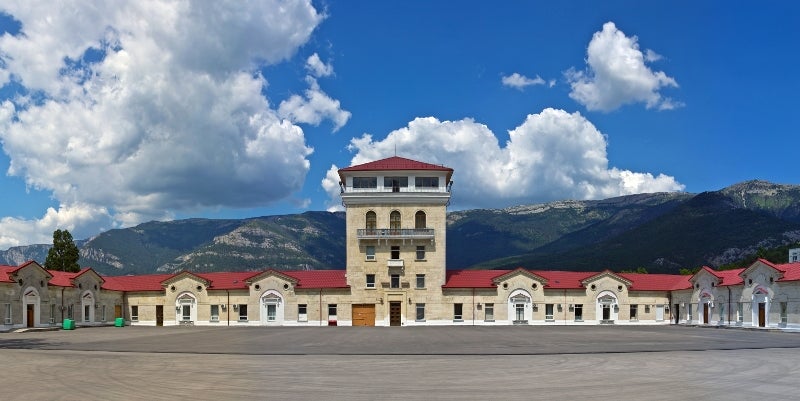
It is the third most famous brand in Russia, after the Lada car and Borjomi mineral water, yet beyond the ex-Soviet states only the most serious wine collectors would recognize Massandra.
The sweet fortified wine has a distinguished heritage closely intertwined with Eastern Europe’s turbulent political history, and an equally remarkable evolution in bottle, reaching ideal drinking maturity after 40 to 50 years. Located on the Black Sea in Yalta, on the south coast of the Crimean peninsula, Massandra was established in 1894 by Tsar Nicolas II with the purpose of producing wines for the Russian courts. Prince Lev Golitzin, a Sorbonne-educated lawyer who came to Crimea in the late 1870s, found that the subtropical climate of the region and the protective shields of mountain chains created unique conditions for the production of high-quality fortified and dessert wines and was appointed as Massandra’s first winemaker. The winery’s long tunnels run deep into the granite mountains, providing the perfect low and consistent temperature necessary for long-term aging in oak casks and vats. Still fully operational today, Massandra produces around one million cases a year (of mainly sweet fortified wine). The vast majority of the winery’s output is sold in Russia, because sanctions prevent Massandra being exported to the West. The controversial Russian annexation of Crimea in 2014 saw the ownership of the winery revert to the Russian government from the Ukrainian government, with subsequent management changes.

Bust of Prince Lev Golitzin at Massandra
Key points in Massandra’s history
• 1894 – Tsar Nicolas II founded the winery.
• 1918 – During the Russian Revolution, Stalin instructed all wines from all the Russian Royal Palaces to be consolidated into the cellars of the Massandra Winery.
• 1922 – Following the establishment of the USSR the winery was nationalized.
• 1936 – Massandra is offered state protection.
• 1942 – Stalin ordered the entire Massandra Collection to be shipped to Georgia to protect it from the risk of Nazi occupation
The Massandra Collection refers to the very top selection of wines made at the winery each year and accounts for less than 1 percent of it annual production. It also contains wines from the Tsar’s collection dating back to 1775, such as the notorious 1775 Jerez de la Frontera that Putin drank with Berlusconi while touring the cellar.
In March 2018, Fine and Rare hosted a special tasting from the Massandra Collection at the Groucho Club in London. Tim Littler purchased the wines in the tasting directly from Massandra in two separate batches, while he operated his wine and travel company, GW Travel Ltd, in the early 1990s. Tim revealed that the opportunity to acquire the bottles came following the fall of Communism, when
because of Russia’s ban on importing the wines, Massandra was desperate to raise cash in order to pay the winery’s 4,500 staff, who earned on average $10 a month. He purchased 5,000 bottles, of which 1,000 bottles remain today.

Rare wines in Massandra’s cellars
Unfortunately very little accurate technical information is available on the wines. The grapes are not late picked and there is no botrytis—in fact they are picked relatively early, retaining very high acidity levels and natural sugar. The wine ferments to 2.5% ABV before being fortified, thereby preserving the residual sugar and the high malic acid. The alcohol level is usually 16%, and there are no available records on residual sugar levels.

Alushta vineyard on the Black Sea coast
The Wines
Massandra White Muscat 1983
Deep amber hue. Sweet toffee and orange-peel aromas. Sweet honeyed palate balanced with a burst of fresh acidity; complex, with layers of dried and fresh fruit and a floral touch through to a long finish and a clean sensation throughout.
Massandra Kokur Surozh 1971
Dark tawny hue. The nose has a distinctly vegetal/herbaceous fragrance dominating the underlying dried-fruit notes. Very sweet palate, with an equally high acidity; lightly fortified. Everything in perfect proportion, with a long finish.
Massandra White Muscat Livadia 1964
Surprisingly, the older the wines are, the fresher they seem. A mixture of botanicals, herbs, and dried apricot on the nose. A slightly drier palate (though still sweet), with a subtle medicinal hint.
Massandra White Muscat 1959
A brilliant amber shade but lots of floating sediment. Faintly musky and dusty aromas, and a lackluster palate.
Massandra Pinot Gris 1949
Somewhat cloudy, with a light brown hue. A touch of nutty oxidation yet still fresh for its age, with a distinct apricot scent. Very balanced and clean, complex and layered.
Massandra Kagor Ayu Dag (red) 1939
This wine is made from a red grape but now has a vivid tawny hue. Dried red currants and mixed spice aromas. A more robust palate, with high acidity and sweetness, and just a sliver of tannin, almost non-existent.
Massandra Tokay Al-Danil 1894
Dull brown and very cloudy, with lots of very fine sediment. Remarkably drinkable! An exceptionally crisp acidity, sweet dried fruit, and fine layers of spice and wild herbs. A long, complex finish.







